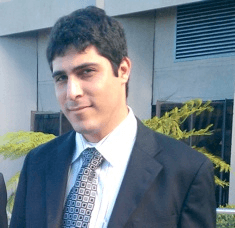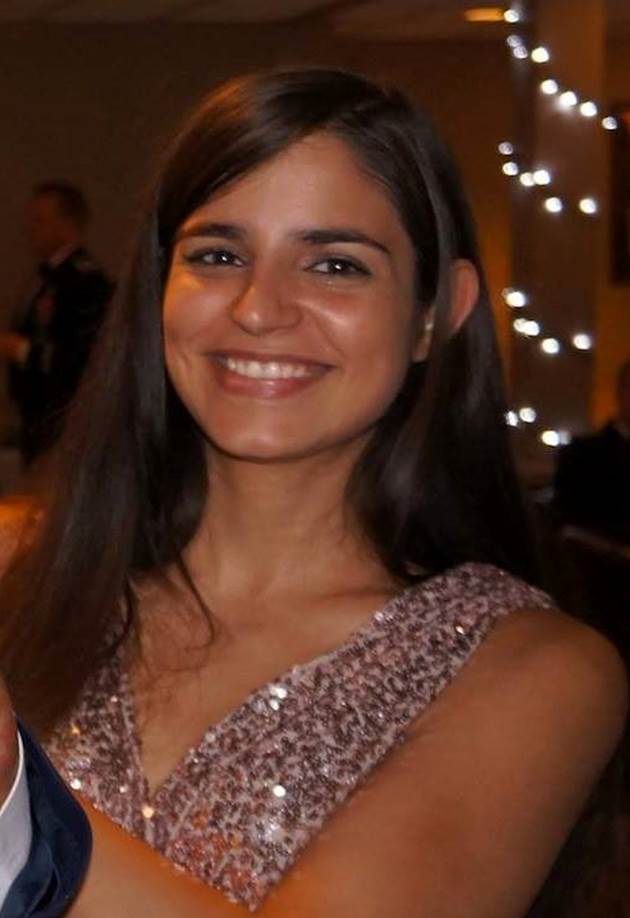 Timothy Cleland, Ph.D. University of Texas at Austin NIH CORE Postdoctoral Scholar Department of Chemistry Email: tpcleland@utexas.edu |
"UV Photodissociation for analysis of intact proteins" Timothy Cleland earned a B.S. in geosciences at Colorado State University in 2007 and a Ph.D. in molecular paleontology at North Carolina State University in 2012. His graduate research focused on mass spectrometry characterization of proteins from fossil bone and soft tissues. His research has led him to broad studies of the bone proteome, especially related to osteoporosis and bone fragility. His work as a CORE postdoctoral fellow is focusing on applying ultraviolet photodissociation (UVPD) for characterization of intact proteins and their post-translational modifications in a high-throughput way. This research has the potential to allow for a deeper understanding of protein changes associated with disease. |
|
|
|
 Oana I. Lungu, Ph.D. University of Texas at Austin NIH CORE Postdoctoral Scholar Department of Chemical Engineering Email: oilungu@gmail.com |
Structural modeling and characterization of the paired VH-VL human immunoglobulin repertoire Oana Lungu earned a B.S. in biochemistry from the University of Minnesota Twin Cities and a Ph.D. in Biochemistry from the University of North Carolina at Chapel Hill. During her graduate studies, she worked on computationally designing, expressing, and characterizing light-activated proteins, which allow for the manipulation of protein signaling networks. As a Postdoctoral fellow, Oana is applying her knowledge of computational protein structure modeling to a different problem: antibody structure prediction. Diversity in the sequences and structures of antibodies that constitute the human immune repertoire is critical for mounting an effective response against foreign antigens. The naïve B cell immunoglobulin repertoire, in particular, which has had no prior antigen exposure and has not been diversified through hypermutation, must have a large enough structural diversity to bind any possible novel antigen, while at the same time minimizing binding to any self-antigens. Oana’s research under the mentorship of George Georgiou and Andrew Ellington seeks to characterize and understand the structural antibody repertoire and its relationship to sequence in B cell populations, including naïve B cells. This research has the potential to further our understanding of how adaptive immune reactions develop in response to various antigens, such as those caused by cancers or immunizations. |
|
|
|
 Hugo V. Miranda, Ph.D. University of Texas at Austin NIH CORE Postdoctoral Scholar Department of Molecular Biosciences Email: hvmiranda@austin.utexas.edu |
“Characterization of horizontally acquired genetic elements that contribute to Vibrio cholerae fitness” Hugo V. Miranda earned a B.S. and a Ph.D. in microbiology and cell science from the University of Florida. During his graduate studies, his research focused on the identification and characterization of protein modifiers in the haloarchaeon Haloferax volcanii. These protein modifiers are analogous to the eukaryotic protein ubiquitin. Two of the three protein modifiers identified were also shown to be potentially involved in sulfur transfer pathways for the biosynthesis of biomolecules. Currently, his postdoctoral research, under the direction and leadership of Dr. Bryan Davies at the University of Texas at Austin, focuses on identifying factors that affect the fitness and pathogenicity of Vibrio cholerae, the causative agent of the potentially deadly disease cholera. He is particularly interested in factors that may impact the evolution and shifts of pandemic V. cholerae strains. His current research seeks to identify protein effectors encoded within the horizontally acquired Vibrio 7TH pandemic island-1 (VSP-1) that may contribute to colonization of the host intestine and/or facilitate survival within the host. The VSP-1 is one of only two pathogenicity islands unique to the current pandemic El Tor V. cholerae strains, and in part, may be contributing to the success of El Tor biotypes as pandemic strains. Understanding how VSP-1 contributes to the fitness of V. cholerae may provide insight into potential new targets for prevention and/or therapeutic options. |
|
|
|
 Lindsay Morrison, Ph.D. University of Texas at Austin NIH CORE Postdoctoral Fellow Department of Chemistry Email: lmorrison21@gmail.com |
Lindsay Morrison earned a B.A. in Chemistry at Colorado College in 2009 and a Ph.D. in analytical chemistry at Ohio State University in 2014. Her graduate work focused on improving the understanding of collision based activation methods in mass spectrometry in order to develop mass spectrometry as a structural biology tool for probing protein structure. Native mass spectrometry approaches are rapidly developing as accepted structural biology tools as the characterization of the primary, sequence, structure of proteins and quaternary architecture proteins is possible by activating and dissociating intact proteins in the gas phase. Using well-characterized helical peptides and proteins, she demonstrated that protein secondary structure exists in fragment ions following collision based activation of the precursor molecule, a result that has important implications for using tandem mass spectrometry methods to investigate protein secondary structure. Her work as a Core postdoctoral fellow is directed at developing applications of ultra-violet photo-dissociation (UVPD), a relatively new activation technique, for the characterization of protein and lipid structures. Because UV photons are highly energetic, activation by UVPD permits cleavage of high energy bonds, cleavage of which is not typically possible by collision-based activation techniques. In lipids and lipid containing molecules, this often results in the formation of unique fragment ions that provide highly informative structural information. Lindsay is using UVPD and an alternative technique, activated ion negative electron dissociation (AI-nETD), to characterize lipid A and ganglioside molecules. The short timescale of the activation event and rapid deposition of energy inherent to photoactivation permits retention of non-covalent interactions during dissociation. Lindsay is researching ways to exploit this feature in native proteins, including using the relative abundance and charge state of the fragments to identify salt bridge partners. |
|
|
|
 Felix R. Perez, Ph.D. University of Texas at Austin Department of Chemistry Email: perez.felix.r@gmail.com |
Rapid Synthesis of Abietanes via a Geranylation-Polyene Cyclization Sequence Felix Perez obtained his BS in Chemistry from California State University, Fresno. Afterwards he went to UCLA and obtained a PhD with Michael E. Jung. He is a postdoc in the Krische group at the University of Texas at Austin developing asymmetric methods for natural products synthesis. |
|
|
|
 Sarah Wong, Ph.D. University of Texas at Austin NIH Core Postdoctoral Fellow Department of Chemistry Email: sjwong@utexas.edu |
“Structural and Mechanistic Characterization of the Eukaryotic Elongation Factor 2 Kinase (eEF-2K)”
Sarah Wong earned her B.S. in Biology and Chemistry from Texas Lutheran University and her Ph.D. in Biochemistry from the University of Texas Health Science Center at San Antonio. Her graduate studies focused on the structural characterization of the Polycomb Repressive Complex 1 using x-ray crystallography and nuclear magnetic resonance. As a postdoctoral fellow, she has been working on the structural and mechanistic characterization of the eukaryotic elongation factor 2 kinase (eEF-2K) under the guidance of Dr. Kevin Dalby. |
|
|
|
 Diana Zamora-Olivares, Ph.D. University of Texas at Austin NIH Core Postdoctoral Fellow Department of Chemistry Email: dianapauzo@gmail.com |
“Differential sensing of mitogen-activated protein kinases MAPKs”
Diana Zamora-Olivares earned a B.S. in pharmaceutical chemistry from the National Autonomous University of Mexico (UNAM) and a Ph.D. in organic chemistry from the University of Texas at Austin. During her graduate studies, she worked on developing differential sensing methods to detect and differentiate mitogen-activated protein kinases, which regulate signaling pathways that are involved in different malignances. During the last decade, organic and supramolecular chemistry in combination with fluorescent-based sensing methods have led to the development of chemical biology tools to study protein phosphorylation. However, further challenges remain present to develop better chemical approaches that can allow us to understand the activation/inhibition of specific kinase pathways. The use of differential sensing techniques has allowed classifying structurally similar analytes. Using this approach, one obtains a distinct fingerprint of composite signals produced by the sensor elements allowing for discrimination of different relevant MAP kinases. As a Postdoctoral fellow, Diana is developing new chemical biological tools to fingerprint MAPKs in different models. Overexpression of MAPKs is related with tumorigenesis and acquired drug resistance. Diana’s research under the guidance of Eric V. Anslyn and Kevin N. Dalby seeks to profile and evaluate the differences between healthy, disease and resistant cellular processes. This research has the potential to increase our understanding of targeted kinase therapies. |
Collaborative Opportunities for Research Educators
(CORE)

Contact
Jenny Brodbelt (PI)
jbrodbelt@cm.utexas.edu
Department of Chemistry
1 University Station A5300
University of Texas
Austin, TX 78712